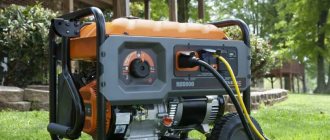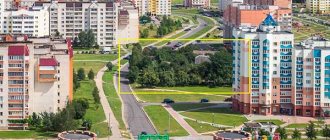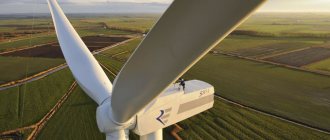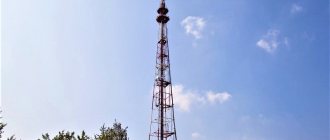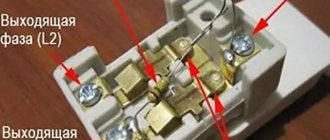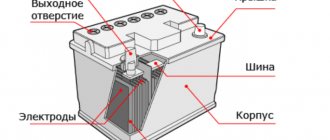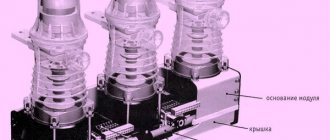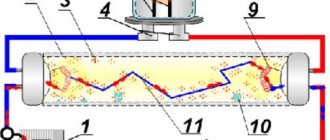With the ever-increasing density and coverage of power transmission networks, the quality and stability are not getting better, and prices are only getting higher every season. One of the best alternative sources of electricity today is an autonomous wind generator for a private home. Let's look at what this device is, what parts it consists of, how it works, what pros and cons it has, what are the legal requirements for its installation, what types exist, and what are the rules for its selection, placement and installation.
Wind power generator for home Source usamodelkina.ru
Wind generator: device, principle of operation, pros and cons
If there are constant winds in the area where you live, purchasing and installing a wind generator is quite advisable. However, before purchasing it, you need to understand its structure, operating principle and main advantages and disadvantages. Let's look at these aspects in more detail.
Main components
The design of a wind generator is based on the conversion of the kinetic force of the wind load into mechanical energy, followed by its conversion into electricity. To implement the sequential actions of this transition chain, the device is equipped with the following main components:
- Bladed propeller. The number of blades can vary widely from model to model - from two and three to ten or more.
- Rotor. The turbine element that rotates under the action of the blades.
- Gearbox. Transmits and regulates the rotation speed from the rotor to the generator.
- Generator. Mechanical force is converted into electricity.
- Inverter is a current converter from AC to DC.
Composition of a wind generator Source odnastroyka.ru
- Accumulator battery. Stores electricity in case of shutdown and economical operation of the wind generator, as well as downtime in case of no wind.
- Protective housing. Protects equipment from various external factors.
- Aero components. Wings, tail - for better capture and adjustment of the propeller to the wind flow.
Note! Modern manufacturers produce wind home generators that do not require strong wind flow. They are able to function productively with a wind force of only 4 m/sec.
Operating principle
The mechanism of operation of the wind generator is directly related to the features of its design - a propeller and a shank are installed on the same axis with a counterweight point located at the point of attachment to the vertical mast. The action occurs according to the following algorithm:
- The propeller and tail mounted on the same axis capture wind flows and transmit them to the blades.
- As the blades begin to rotate, they transmit torque to the generator turbine.
- Rotation of the rotor leads to the formation of an inductive magnetic field and the generation of alternating electric current.
Wind generator on its own country plot Source moe-online.ru
- Then, passing through the inverter, the voltage changes the variable characteristics to constant ones.
- The current powers the battery, which in turn distributes energy to consumer power in the house.
Helpful information! A wind generator can play the role of both the main and additional source of electricity. In the first case, the core from the device powers some of the devices to save or replenish the power shortage of the main network and is used in case of emergency shutdown of the latter. In the second case, it can be an independent source or part of an autonomous system, including hydraulic turbines, solar panels, etc. equipment.
See also: Catalog of companies that specialize in engineering systems (heating, water supply, sewerage and others) and related work
Advantages and disadvantages
An autonomous wind power plant for a private home has the following number of advantages:
- The device operates using a virtually inexhaustible and renewable energy resource.
- Significant costs are associated only with purchase, delivery, installation and connection. Funds are practically spent on maintenance. Therefore, a windmill requires a one-time investment that quickly pays off in subsequent use.
Wind generator - power source for a private home Source ytimg.com
- The resulting type of energy and the technology used for this purpose are completely environmentally friendly.
- Generators are adapted to all climatic zones and are protected from negative weather factors.
- The equipment does not require settings, adjustments or modifications during operation.
The disadvantages of wind generators include:
- Dependence of productivity on the presence of wind.
- During operation, the equipment creates electromagnetic interference, which can negatively affect TV, radio, Internet and communications.
- During extreme weather events, there is a risk of damage to equipment.
- Mandatory grounding is required to protect the device and the structure or building on which it is installed from lightning strikes.
- Incorrect installation, violation of instructions, or operation of a faulty unit can lead to noise.
Advice! To determine whether it will be profitable to install a wind power station to generate current, it is necessary to take into account a number of factors - the power supply option involving the device, the variety of available models, their characteristics, performance and cost.
Wind generator in the courtyard of the house Source pechiexpert.ru
Types of wind generators
According to power and scope of application, wind generators are divided into
- industrial (power from 500 kW);
- household (power 0-10 kW).
Devices with power from 10 to 500 kW are used extremely rarely.
By design, household types of wind turbines differ in the design of the rotor (turbine)
- With horizontal axis. The turbine (rotor) control system differs, it can be:
- aeromechanical (special “flaps” are installed on the blades, which change the angle of the wind direction: the higher the wind speed, the greater the angle of attack of the blades and vice versa). By changing the angle of attack, we can control the turbine at both low and high speeds for efficient and correct operation of the device.
- with an azimuth drive (electronics record the wind speed and direction, turn or turn the turbine away from the wind if the wind speed exceeds the nominal one).
- With vertical axis - These are ineffective devices that are not recommended for use due to a number of disadvantages. They differ in the type of turbines:
- Savonius rotor. Their disadvantage is the advance coefficient. If the wind speed is 10 m/s, then the tip of the turbine will rotate at a speed of 100 m/s, respectively, the advance coefficient is 10. In fact, the wind turbine cannot start on its own, it needs to be spun up and only after that it starts working. If this is not done, then it will begin to generate energy only at a wind speed of 10 m/s or more.
- Darrieus rotor. They are only used as anemoscopes, as they are ineffective.
Nowadays, wind generators with a horizontal axis of rotation (vane-type) are widely used, due to the fact that their wind flow energy utilization factor (WEF) easily reaches 30% or more, and for wind generators with a vertical axis of rotation, WEF is about 20%.
A residential power system using a wind generator is similar to a system with solar modules; both wind generators and solar modules can be used in the same system.
The amount of energy generated depends on the height of the mast and the diameter of the rotor as follows: for every 10 meters the windmill is raised, 1 m/s of wind speed is added. The higher the mast, the more likely it is to perform as efficiently as possible. And the same situation with the rotor: the larger the diameter, the greater the energy production.
Wind flow force values for windmill operation
- The wind speed for the start of rotation of the blades, at which there is no power at all, is from 1.5 m/s.
- The minimum wind speed at which power generation begins is 3 m/s.
- Nominal wind speed (for Ukrainian-made wind generators) is 7-9 m/s.
- The maximum wind speed at which a Ukrainian-made wind generator remains operational is 52 m/s (200 km/h), which indicates the high quality of the installation and the strength of the manufacturing materials.
Legal Requirements
In order for a wind generator installed on a private house or adjacent territory to be consistent with the legal framework, it must meet the following series of requirements:
- Power is not higher than 5 kW. Equipment with this indicator refers to household devices that do not require control by energy regulatory institutions.
- Absence of municipal-territorial and technical restrictions on the occupied area. Some private territories may be located inside specially protected, rare natural or other status objects, within which the placement of certain technical equipment is prohibited.
- Coordination with neighbors (interference, noise, falling shadow, etc.). All types of interference that arise from the installation can cause complaints not only from neighbors, but also from nearby enterprises and transmission centers.
- Mast height to meet local and federal requirements. The height of the mast usually does not exceed 15 meters, but there may be exceptions. Therefore, before constructing a tall structure, you need to make sure that it meets all the necessary requirements - no power lines, away from the airport landing line, etc.
Windmill on the facade of a private house Source more-el.com
- No disturbance to local or migratory species. Birds often get caught in the blades of power plants. Therefore, the choice of location for installing a mast with a propeller should exclude previously known flight paths.
Recommendation! To exclude all possible claims from neighbors or regulatory authorities, it is better to collect in advance all the necessary documents, technical passports and certificates confirming that a wind turbine for a private home is safe and harmless. In addition, it is better to install the factory model in full accordance with the parameters recommended in the technical documentation.
Varieties
In order to choose the right wind generator, you must first take into account its technical parameters. Modern models differ in the following number of characteristics:
- The number of propeller blades. A large number of screw elements complicates the design. However, the more blades, the lower the wind speed needed to start the mechanism.
- Type of blade material. Models with rigid propellers are stronger and more durable, but also much more expensive than their sailing counterparts.
Multi-blade wind generator for your home Source ytimg.com
- The location of the rotation guide. Divided into vertical and horizontal. The former are stronger and more sensitive, the latter have better performance.
- Possibility of changing step characteristics. They differ in models with variable and constant pitch. Products with variable step parameters allow you to increase speed, and therefore productivity. However, they are more complex, bulky and expensive.
Good to know! Factory models widely available today are quite expensive. Therefore, those who want to install such an autonomous power plant often have the question of how to make a wind generator. Homemade analogues are often made from car generators connected according to a circuit with a similar 12-volt battery.
Comments:
Uncle Vova
I assembled a vertical windmill from an oil drum, it worked until winter. The bearings in the generator are covered because... In the spring, it only produced creaking and grinding noises, but no electricity. You need very good bearings.
Evgen
I’ve been hooked up to a regular Zhiguli generator and it’s been working fine for three years now. It illuminates the street, and in the summer I connect a mole repeller to it. It seems to me that the problem is not in the bearings, but in the tightness.
Bogdan
Evgen, of course, the problem is tightness, but if you install seals that will not allow moisture to pass into the bearing, the efficiency of the entire structure will decrease. So I’m thinking, what should I do? Should I leave everything open or seal it as much as possible?
Igor
People, what are you talking about? Do you want to protect your car generator with something else? Yes, it is designed to work in such extreme conditions that a windmill (even one made from a barrel) is a vacation for it! There is always water, dirt and snow under the hood and the temperatures are the most extreme. The fact that Uncle Vova’s bearings broke on his auto-generator means that they had been broken for a long time, and were waiting for the “right moment” to announce it.
Vladimir
Bearings must be taken from 18 GPP, or from France, Sweden. I think SKF bearings with original lubrication (hub) have been working for 12 years, and there is zero noise.
Madi
The most advanced vertical-axis wind generator https://www.facebook.com/madiz.zhakypov/posts/10154799110278007
Virtual Private Server
That is, it turns out that people are simply being deceived by saying that vertical wind generators are more efficient in low winds. There are also Daria rotors, they are faster and larger than KIEV, but they have problems with starting in low winds and uneven thrust, and their calculation is very complicated.
Michael
One thing is clear: the windmill must be installed in “batteries” of three to six... pieces. Then it will make sense. At least heat the water.
Leave a comment Cancel reply
Related Posts
High-quality electrics for every home
Features of metal cable trays
Photo manual: DIY solar battery step by step
Fuel-free generator - a way to make money on illiteracy
Criterias of choice
When choosing a wind generator, in addition to technical characteristics, it is also necessary to correctly set the required power. It is set by such a parameter as the diameter of the rotor, which can be calculated using the following formula:
Egod = 1.64 * D2 * O3
Egod – total electricity consumed by appliances at home per year, kW,
D – rotor diameter, indicated in meters,
О – average annual wind speed, meter/second.
By substituting known parameters into this form, it is possible to calculate what diameter rotor a wind power plant for a home should be equipped with in a particular case.
How to make your own wind generator
The answer to this question lies in the level of human training in theoretical or technical terms. The usual workflow is approximately as follows:
- creating a project
- product of all available calculations
- preparation of materials
- purchasing system elements that cannot be made independently (for example, batteries)
- manufacturing of rotating parts (rotor)
- installing the rotor, checking performance, making the necessary design changes
- assembly of the generator (if you plan to assemble it yourself, rather than using ready-made samples)
- connecting the entire system into a complex, test run
- system setup, adjustment work
- exploitation
Useful video
The order of work is determined conditionally; each specific case has its own conditions or possibilities. Some users do without equipment, connecting consumption devices directly to the generator. Not all devices or appliances allow you to do this, but, for example, heating elements can be turned on this way. This is done if there is no additional equipment yet, but you already need to heat the water. In addition, it is necessary that the wind speed be more or less constant and even.
Posting rules
When installing the device, the following requirements must be taken into account:
- There should be no structures, bushes, trees or other obstacles in the vicinity of the generator to obstruct the free passage of wind flows.
- To prevent noise and interference from work from having a negative impact on others, it is better to place windmills for the home at least 30 meters away from the home.
- To avoid weakening wind flows, it is better to install the mechanism 2-3 meters higher than surrounding obstacles, even if they are located at a distance of up to 200 meters.
Installation Features
An industrially manufactured or home-made wind turbine must be installed in compliance with the following minimum requirements:
- It is better to select an installation location on a hill, away from obstacles, and place the device at a height of at least 10 meters from the ground surface.
- The mast must have a reliable base - preferably concrete.
- It is necessary to place a small canopy over the windmill to protect it from precipitation.
- If replacement, repair or maintenance is necessary, the folding design of the mast will allow easier access to the equipment.
On a note! When deciding how to make a windmill so that it is durable and easy to maintain, you need to pay attention to the number of phases generated by the device. Thus, three-phase models, compared to single-phase analogues, do not hum, do not vibrate and are characterized by a better service life.
Connecting the installation to the consumer
Connecting a wind generator is associated with the need to convert energy before supplying it to the consumer.
- The generated electricity is supplied to the controller.
- The controller changes the voltage characteristics and supplies it to the battery.
- The battery charges and stores energy.
- The controller takes part of the energy and supplies it to the inverter.
- An inverter converts direct voltage into alternating voltage and supplies it to the facility’s power supply network.
Before you buy a wind generator or decide to make a wind power plant yourself, you need to evaluate the operating conditions of the installation.
Briefly about the main thing
A wind generator for home is one of the best alternative sources of electricity. The principle of its operation is based on converting the kinetic energy of the wind into mechanical energy, and then, with the help of a rotor, into electrical energy. Among its main advantages are:
- Work using an inexhaustible source of energy – wind.
- Costs are associated only with purchase and installation; the equipment is durable and does not require special maintenance.
- Adaptability for any climate.
- An environmentally friendly type of energy resource.
Disadvantages include dependence on wind force, interference, and the possibility of destruction during extreme weather events. The installation of a wind generator must comply with legal requirements - power, height, restrictions, coordination with neighbors and absence of biological harm. Models differ in technical parameters - the number of blades, the type of their material, the direction of the axis of rotation and pitch variability. When choosing, you need to take into account the rotor diameter, which determines the power. Installation of the device must comply with the placement rules and practical recommendations.
Advantages of wind power plants:
Having many advantages, wind turbines have won the love of farmers and owners of country houses. There are usually three main advantages:
1. environmental friendliness,
2. ease of maintenance,
3. independence from external sources of energy supply.
The environmental friendliness of this type of electricity generation lies in the absence of harmful effects on the environment - there are no exhaust gases, no deforestation, no release of harmful substances into rivers or other bodies of water.
Due to the fairly simple energy generation system, the design does not require labor-intensive maintenance and operates autonomously. For busy people, saving time is a big plus in generating energy using wind.
Due to the independence of wind devices from fuel reserves or external energy sources, there is a guarantee of a constant supply of electricity. However, there are several disadvantages associated with this fact.



